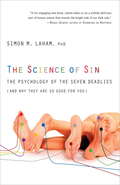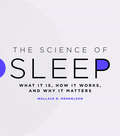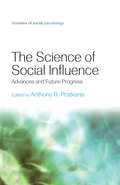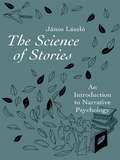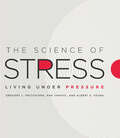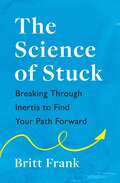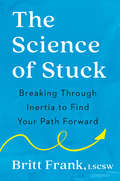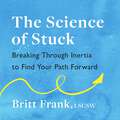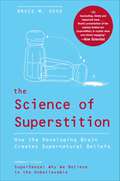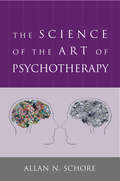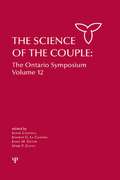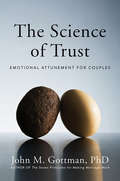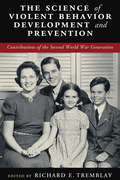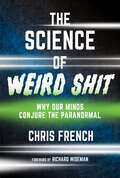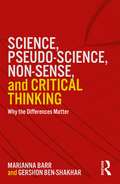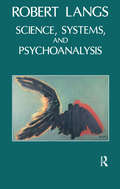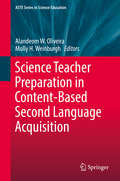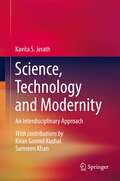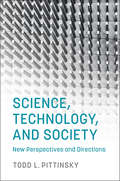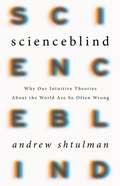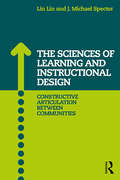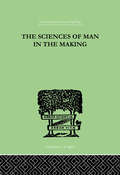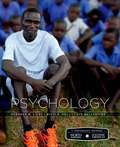- Table View
- List View
The Science of Sin
by Simon M. LahamPride, lust, gluttony, greed, envy, sloth, and anger.They're considered "deadly" because of their capacity to generate other evils. The truth is, we all sin and we do it all the time--in fact, usually several times over before breakfast! But human behavior, argues social psychologist Simon Laham, is more complex than "good" or "evil." In psychology, these sins aren't considered morally wrong or even uniformly bad, but are treated rather as complex and interesting psychological states that if, indulged wisely, can be functional, adaptive, and lead to a range of positive effects. The Science of Sin takes on these so-called sins one by one and through psychological research shows that being bad can be oh-so-good for you. Did you know that: · Being slow and lazy can help you win the race? · Anger makes you more open-minded? · Coveting what others have not only makes you more creative but bolsters self- esteem? So go ahead, eat that last cookie and kick back on the couch for a day of TV with your neighbor's boyfriend--from gluttony to greed, envy to lust, Laham shows how even the deadliest, most decadent of vices can make you smart, successful, and happy.
The Science of Sleep: What It Is, How It Works, and Why It Matters
by Wallace B. MendelsonWe often hear that humans spend one third of their lives sleeping—and most of us would up that fraction if we could. Whether we’re curling up for a brief lunchtime catnap, catching a doze on a sunny afternoon, or clocking our solid eight hours at night, sleeping is normally a reliable way to rest our heads and recharge our minds. And our bodies demand it: without sufficient sleep, we experience changes in mood, memory loss, and difficulty concentrating. Symptoms of sleep deprivation can be severe, and we know that sleep is essential for restoring and rejuvenating muscles, tissue, and energy. And yet, although science is making remarkable inroads into the workings and functions of sleep, many aspects still remain a mystery. In The Science of Sleep, sleep expert Wallace B. Mendelson explains the elements of human sleep states and explores the variety of sleep disorders afflicting thousands of people worldwide. Mendelson lays out the various treatments that are available today and provides a helpful guide for one of life’s most important activities. By offering the first scientific yet accessible account of sleep science, Mendelson allows readers to assess their personal relationships with sleep and craft their own individual approaches to a comfortable and effective night’s rest. Addressing one of the major public health issues of the day with cutting-edge research and empathetic understanding, The Science of Sleep is the definitive illustrated reference guide to sleep science.
The Science of Social Influence: Advances and Future Progress (Frontiers of Social Psychology)
by Anthony R. PratkanisThe contributions to this volume capture the thrill of current work on social influence, as well as providing a tutorial on the scientific and technical aspects of this research. The volume teaches the student to: Learn how to conduct lab, field and case research on social influence through example by leading researchers Find out about the latest discoveries including the status of research on social influence tactics, dissonance theory, conformity, and resistance to influence Discover how seemingly complex issues such as power, rumors, group and minority influence and norms can be investigated using the scientific method Apply knowledge to current influence campaigns to find out what works and what does not. The Science of Social Influence is the perfect core or complementary text for advanced undergraduate or graduate students in courses such as Attitudes and Attitude Change, Communications, Research Methods and, of course, Social Influence.
The Science of Stories: An Introduction to Narrative Psychology
by János LászlóThe Science of Stories explores the role narrative plays in human life. Supported by in-depth research, the book demonstrates how the ways in which people tell their stories can be indicative of how they construct their worlds and their own identities. Based on linguistic analysis and computer technology, Laszlo offers an innovative methodology which aims to uncover underlying psychological processes in narrative texts. The reader is presented with a theoretical framework along with a series of studies which explore the way a systematic linguistic analysis of narrative discourse can lead to a scientific study of identity construction, both individual and group. The book gives a critical overview of earlier narrative theories and summarizes previous scientific attempts to uncover relationships between language and personality. It also deals with social memory and group identity: various narrative forms of historical representations (history books, folk narratives, historical novels) are analyzed as to how they construct the past of a nation. The Science of Stories is the first book to build a bridge between scientific and hermeneutic studies of narratives. As such, it will be of great interest to a diverse spectrum of readers in social science and the liberal arts, including those in the fields of cognitive science, social psychology, linguistics, philosophy, literary studies and history.
The Science of Stress: Living Under Pressure
by Gregory L. Fricchione Ana Ivkovic Albert S. YeungOur jobs and families; the deluge of e-mails, texts, and calls; the constant pinch on our time and money; the screaming match of politics and the threat of terrorism and war--there is no doubt about it, we are completely stressed out. Most of the time, we just shrug it off, but as neuropsychiatrists Gregory L. Fricchione, Ana Ivkovic, and Albert Yeung gently remind us in this book: stress can be really, really bad for our health. In fact, persistent stress is directly linked to chronic ailments like heart disease, diabetes, and depression, contributing to one of the biggest health challenges facing the world in the twenty-first century. Expertly but sensitively guiding readers through the latest research in the science of stress, they offer an illuminating and therapeutic look at our own worst enemy. As Fricchione and his colleagues show, alleviating stress is a task that no one physician can alleviate for us on his own. It is not the sort of problem that a surgeon can excise with a scalpel or an internist can eradicate with antibiotics. It requires everyone's efforts--the healthy, the sick, doctors, nurses, psychologists, clergy, community leaders, and everyone else--to pull together to address the stress-induced drivers in our community that undermine our health. Clearly and accessibly exploring the latest in modern neuroscience and immunology, the authors examine what those drivers are and how they reduce the body's metabolic reserve, making us more vulnerable to illness. They then look at the antidote: enhanced resilience, something we can achieve by smartly adjusting how we face the significant adversities that can spring up in so many facets of our lives. Offering innumerable insights on the personal and social causes of stress and the physiological effects they have, this book serves as an essential guide to show us how to alleviate stress and properly take care of ourselves. In doing so, it offers a crucial first step toward meeting the biggest health challenge of this century.
The Science of Stuck
by Britt FrankWe all experience stuckness in our lives. We feel stuck in our relationships, career paths, body struggles, addiction issues, and more. Many of us know what we need to do to move forward--but find ourselves unable to take the leap to make it happen. And then we blame and shame ourselves, and stay in a loop of self-doubt that goes nowhere.The good news is you're not lazy, crazy, or unmotivated. In this empowering and action-oriented guide, you'll discover why we can't think our way forward--and how to break through what's holding us back. Using an eclectic approach and a customizable plan that's as direct or as deep as you want, this life-changing guide empowers you to:- break old habits and patterns- gain perspective on pain and trauma from the past- free yourself from the torturous "why" questions- take control of your choices to create the life you wantBringing together research-backed solutions that range from shadow work to reparenting, embodied healing, and other clinical practices, along with empowering personal stories, this book is a hands-on road map for moving forward with purpose, confidence, and the freedom to become who you're truly meant to be.
The Science of Stuck: Breaking Through Inertia to Find Your Path Forward
by Britt FrankA research-based tool kit for moving past what&’s holding you back—in life, in love, and in work.We all experience stuckness in our lives. We feel stuck in our relationships, career paths, body struggles, addiction issues, and more. Many of us know what we need to do to move forward—but find ourselves unable to take the leap to make it happen. And then we blame and shame ourselves, and stay in a loop of self-doubt that goes nowhere. The good news is you&’re not lazy, crazy, or unmotivated. In this empowering and action-oriented guide, you&’ll discover why we can&’t think our way forward—and how to break through what&’s holding us back. Using an eclectic approach and a customizable plan that&’s as direct or as deep as you want, this life-changing guide empowers you to: break old habits and patternsgain perspective on pain and trauma from the pastfree yourself from the torturous &“why&” questionstake control of your choices to create the life you want Bringing together research-backed solutions that range from shadow work to reparenting, embodied healing, and other clinical practices, along with empowering personal stories, this book is a hands-on road map for moving forward with purpose, confidence, and the freedom to become who you&’re truly meant to be.
The Science of Stuck: Breaking Through Inertia to Find Your Path Forward
by Britt FrankWe all experience stuckness in our lives. We feel stuck in our relationships, career paths, body struggles, addiction issues, and more. Many of us know what we need to do to move forward--but find ourselves unable to take the leap to make it happen. And then we blame and shame ourselves, and stay in a loop of self-doubt that goes nowhere.The good news is you're not lazy, crazy, or unmotivated. In this empowering and action-oriented guide, you'll discover why we can't think our way forward--and how to break through what's holding us back. Using an eclectic approach and a customizable plan that's as direct or as deep as you want, this life-changing guide empowers you to:- break old habits and patterns- gain perspective on pain and trauma from the past- free yourself from the torturous "why" questions- take control of your choices to create the life you wantBringing together research-backed solutions that range from shadow work to reparenting, embodied healing, and other clinical practices, along with empowering personal stories, this audiobook is a hands-on road map for moving forward with purpose, confidence, and the freedom to become who you're truly meant to be.(P) 2022 Penguin Audio
The Science of Superstition: How the Developing Brain Creates Supernatural Beliefs
by Bruce M. HoodIn The Science of Superstition, cognitive psychologist Bruce Hood examines the ways in which humans understand the supernatural, revealing what makes us believe in the unbelievable.*Previously published as SuperSense.
The Science of the Art of Psychotherapy (Norton Series on Interpersonal Neurobiology)
by Allan N. SchoreThe latest work from a pioneer in the study of the development of the self. Focusing on the hottest topics in psychotherapy--attachment, developmental neuroscience, trauma, the developing brain--this book provides a window into the ideas of one of the best-known writers on these topics. Following Allan Schore's very successful books on affect regulation and dysregulation, also published by Norton, this is the third volume of the trilogy. It offers a representative collection of essential expansions and elaborations of regulation theory, all written since 2005. As in the first two volumes of this series, each chapter represents a further development of the theory at a particular point in time, presented in chronological order. Some of the earlier chapters have been re-edited: those more recent contain a good deal of new material that has not been previously published. The first part of the book, Affect Regulation Therapy and Clinical Neuropsychoanalysis, contains chapters on the art of the craft, offering interpersonal neurobiological models of the change mechanism in the treatment of all patients, but especially in patients with a history of early relational trauma. These chapters contain contributions on "modern attachment theory" and its focus on the essential nonverbal, unconscious affective mechanisms that lie beneath the words of the patient and therapist; on clinical neuropsychoanalytic models of working with relational trauma and pathological dissociation: and on the use of affect regulation therapy (ART) in the emotionally stressful, heightened affective moments of clinical enactments. The chapters in the second part of the book on Developmental Affective Neuroscience and Developmental Neuropsychiatry address the science that underlies regulation theory's clinical models of development and psychopathogenesis. Although most mental health practitioners are actively involved in child, adolescent, and adult psychotherapeutic treatment, a major theme of the latter chapters is that the field now needs to more seriously attend to the problem of early intervention and prevention. Praise for Allan N. Schore: "Allan Schore reveals himself as a polymath, the depth and breadth of whose reading-bringing together neurobiology, developmental neurochemistry, behavioral neurology, evolutionary biology, developmental psychoanalysis, and infant psychiatry-is staggering." -British Journal of Psychiatry "Allan Schore's...work is leading to an integrated evidence-based dynamic theory of human development that will engender a rapproachement between psychiatry and neural sciences."-American Journal of Psychiatry "One cannot over-emphasize the significance of Schore's monumental creative labor...Oliver Sacks' work has made a great deal of difference to neurology, but Schore's is perhaps even more revolutionary and pivotal...His labors are Darwinian in scope and import."-Contemporary Psychoanalysis "Schore's model explicates in exemplary detail the precise mechanisms in which the infant brain might internalize and structuralize the affect-regulating functions of the mother, in circumscribed neural tissues, at specifiable points in it epigenetic history." -Journal of the American Psychoanalytic "Allan Schore has become a heroic figure among many psychotherapists for his massive reviews of neuroscience that center on the patient-therapist relationship." -Daniel Goleman, author of Social Intelligence
The Science of the Couple: The Ontario Symposium Volume 12 (Ontario Symposia on Personality and Social Psychology Series)
by Lorne Campbell James M. Olson Jennifer G. La Guardia Mark P. ZannaAlthough love and relationships have been focal points for poets and philosophers for thousands of years, these topics had not traditionally been the focus of empirical research. As a result, very little was known about how couples maintained happiness and satisfaction in their relationships, or how relationships deteriorated, ultimately ending in separation or divorce. However, since the early 1980s, relationships research has blossomed as a field – and is now one of the most vibrant topics in social psychology and beyond. This volume brings together the latest research on couple functioning from the perspectives of social and personality psychology, neurobiology, health, and clinical psychology. Additionally, the research presented highlights the use of survey, experimental, implicit, and longitudinal methods, as well as specialized techniques employed in neuroscience, psychophysiology, and psychoneuroimmunology in the study of couple level processes. The underlying aim of this volume is to examine how these theories and methods converge to provide a deeper, holistic model of couples’ processes and functioning. With its state-of-the-art, integrative overview of this exciting discipline, The Science of the Couple is essential reading for social psychologists, clinicians, and anyone with an interest in the dynamics of interpersonal relationships.
The Science of Trust: Emotional Attunement For Couples (Playaway Adult Nonfiction Ser.)
by John M. GottmanAn eminent therapist explains what makes couples compatible and how to sustain a happy marriage. For the past thirty-five years, John Gottman's research has been internationally recognized for its unprecedented ability to precisely measure interactive processes in couples and to predict the long-term success or failure of relationships. In this groundbreaking book, he presents a new approach to understanding and changing couples: a fundamental social skill called "emotional attunement," which describes a couple's ability to fully process and move on from negative emotional events, ultimately creating a stronger relationship. Gottman draws from this longitudinal research and theory to show how emotional attunement can downregulate negative affect, help couples focus on positive traits and memories, and even help prevent domestic violence. He offers a detailed intervention devised to cultivate attunement, thereby helping couples connect, respect, and show affection. Emotional attunement is extended to tackle the subjects of flooding, the story we tell ourselves about our relationship, conflict, personality, changing relationships, and gender. Gottman also explains how to create emotional attunement when it is missing, to lay a foundation that will carry the relationship through difficult times. Gottman encourages couples to cultivate attunement through awareness, tolerance, understanding, non-defensive listening, and empathy. These qualities, he argues, inspire confidence in couples, and the sense that despite the inevitable struggles, the relationship is enduring and resilient. This book, an essential follow-up to his 1999 The Marriage Clinic, offers therapists, students, and researchers detailed intervention for working with couples, and offers couples a roadmap to a stronger future together.
The Science of Violent Behavior Development and Prevention: Contributions of the Second World War Generation
by Richard E. TremblayThis book describes the lives of 12 people born in Europe and North America during the Second World War. They became leading scholars on the development and prevention of violent human behavior. From the first to the last page, the book introduces contrasting life-stories and shows how their paths crossed to create a relatively unified body of knowledge on how human violence develops and possible prevention methods. The authors describe the similarities and differences in their family background, university training, theories, and collaborations. Not to mention how they differ in research methods, scientific conclusions, and their influence on the research published today. These comparisons celebrates the diversity of their experience and, in turn, their achievements. By knowing this, you can stand on the shoulders of these giants to look to the future of this subject and potentially contribute to its next steps.
The Science of Weird Shit: Why Our Minds Conjure the Paranormal
by Chris FrenchAn accessible and gratifying introduction to the world of paranormal beliefs and bizarre experiences.Ghostly encounters, alien abduction, reincarnation, talking to the dead, UFO sightings, inexplicable coincidences, out-of-body and near-death experiences. Are these legitimate phenomena? If not, then how should we go about understanding them? In this fascinating book, Chris French investigates paranormal claims to discover what lurks behind this &“weird shit.&” French provides authoritative evidence-based explanations for a wide range of superficially mysterious phenomena, and then goes further to draw out lessons with wider applications to many other aspects of modern society where critical thinking is urgently needed.Using academic, comprehensive, logical, and, at times, mathematical approaches, The Science of Weird Shit convincingly debunks ESP, communicating with the dead, and alien abduction claims, among other phenomena. All the while, however, French maintains that our belief in such phenomena is neither ridiculous nor trivial; if anything, such claims can tell us a great deal about the human mind if we pay them the attention they are due. Filled with light-bulb moments and a healthy dose of levity, The Science of Weird Shit is a clever, memorable, and gratifying read you won&’t soon forget.
Science, Pseudo-science, Non-sense, and Critical Thinking: Why the Differences Matter
by Gershon Ben-Shakhar Marianna BarrScience, Pseudo-science, Non-sense, and Critical Thinking shines an unforgiving light on popular and lucrative ‘miraculous’ practices that promise to offer answers during times of trouble. Throughout the book, the authors unfold the fallacies underlying these practices, as well as consumers’ need and desire to believe in them. Adopting a scientific approach, the book critically evaluates research into cold-reading practices, such as those that claim to be able to communicate with the afterlife or posess supernatural powers, before considering a range of pseudo-sciences including graphology and polygraph interrogation, exposing the pretensions of these practices in a clear and logical fashion. The book seeks to encourage critical thinking throughout, asking whether there is any scientific evidence to support these practitioners’ abilities to supply us with reliable answers, and discussing the various factors that comprise the psychological mechanism of belief. Written in a fluent and accessible style, Science, Pseudo-science, Non-sense, and Critical Thinking is aimed at interested professionals and the public at large.
Science, Psychoanalysis, and the Brain
by Shimon MaromScience, Psychoanalysis, and the Brain is an invitation to a space for dialogue where reflections on neurophysiology are expressed with and guided by depth-psychology in mind; a space where neurophysiology resumes its traditional humbled stance towards matters of the psyche, and where the intellectual autonomy of depth psychology is acknowledged. The author leads the reader through the terrain of methodological errors that have plagued recent reductive approaches, paving the way for a dialogue that is based on an alternative, relational approach. Neurophysiology is discussed on a high level of abstraction, enabling a genuine analysis of the organization of the brain through its relational interactions with the world. In this dialogue, where psychology provides a theoretical framework that contributes to physiology, both parties benefit. Neurophysiology gains important constraints and guidance in phrasing meaningful questions, whilst psychology gains further motivation to crystalize its multifaceted concepts. Both disciplines enrich the spectrum of metaphors available to them within their own discourses.
Science, Systems and Psychoanalysis
by Robert LangsThis book has been written for a broad audience. It is addressed to anyone who is at all concerned with a scientific grounding for the art of psychotherapy and psychoanalysis, and for the understanding of the human mind and its outputs via emotionally charged communication. The book begins by establishing the need for a formal science of psychoanalysis and then presents the distinctive features of the communicative approach that moved it towards the creation of that science.
Science Teacher Preparation in Content-Based Second Language Acquisition
by Alandeom W. Oliveira Molly H. WeinburghThe primary purpose of this book is to provide science teacher educators with exemplars of professional development programs designed to prepare school teachers to effectively help language learners in science classrooms simultaneously gain language proficiency and conceptual understanding. To this end, this book examines seventeen science teacher preparation programs that span a wide variety of grade levels (elementary, middle, and secondary), countries (Italy, Luxemburg, Spain, UK, and US), and linguistic contexts (English as a Second Language, English as a Foreign Language, trilingual classrooms, and teaching deaf children science through sign language). The book is divided into three main parts. Each part consists of chapters that illustrate a common, cross-cutting theme in science teacher preparation in content-based second language acquisition, namely pre-service teacher preparation, in-service teacher preparation, and international perspectives. Each part provides many insights on the similarities and differences in the professional development approaches used to prepare science teaching with varied amounts of instructional experience help students in different parts of the world overcome linguistic barriers while simultaneously learning concepts central to science. Bringing together researchers from various academic backgrounds (science education, TESOL, and Applied Linguistics), attention is given to varied facets of the intersection of science and language learning in the specific context of school teacher preparation.
Science, Technology and Modernity: An Interdisciplinary Approach
by Kavita S. JerathThis book provides a full scale description and discussion of science, technology, society, cross-cultural communication and modernity and is presented at a level that makes it accessible to the interested academic. Starting with the historical overview, the text outlines the relevance of technology today and in the future. Then follows an introduction to the discovery and invention by agricultural, feudal, capitalist and socialist systems, and conversely the ways in which science and technology has altered economic, social, and political beliefs and practices during industrial revolutions and have transformed the whole nature of human society. Tracing the relationship between science and technology from dawn to civilization to the twenty first century, the book argues that technology is applied science and vice versa and this phenomenon emerged relatively recently, as industry and governments began funding scientific research that would lead to new technologies. The book goes beyond technology by also describing the path from modernity to post modernity and discussing the theories of modernity. Further the internet and social media receive increased attention as well. Finally, the discussion turns to the future structure of society and gender equality, expected to have a more distributed future generation, thereby addressing the synergies between education system, globalization and cross-cultural communication.This book is designed as the primary general textbook for Engineers at the undergraduate level in any university. This course is a multidisciplinary elective course from emerging areas in the 4- year institution and is a required course in most universities.
Science, Technology, and Society: New Perspectives and Directions
by Todd L. PittinskyThis book gathers inter-disciplinary and multi-disciplinary perspectives on the effects that today's advances in science and technology have on issues ranging from government policy-making to how we see the differences between men and women. The chapters investigate how invention and innovation really take place, how science differs from competing forms of knowledge, and how science and technology could contribute more to the greater good of humanity. For instance, should there be legal restrictions on 'immoral inventions'? A key theme that runs throughout the book concerns who is taken into account at each stage and who is affected. The amount of influence users have on technology development and how non-users are factored in are evaluated as the impact of scientific and technological progression on society is investigated, including politics, economy, family life, and ethics.
Scienceblind: Why Our Intuitive Theories About the World Are So Often Wrong
by Andrew ShtulmanHumans are born to create theories about the world--unfortunately, they're usually wrong, and keep us from understanding the world as it really isWhy do we catch colds? What causes seasons to change? And if you fire a bullet from a gun and drop one from your hand, which bullet hits the ground first? In a pinch we almost always get these questions wrong. Worse, we regularly misconstrue fundamental qualities of the world around us. In Scienceblind, cognitive and developmental psychologist Andrew Shtulman shows that the root of our misconceptions lies in the theories about the world we develop as children. They're not only wrong, they close our minds to ideas inconsistent with them, making us unable to learn science later in life. So how do we get the world right? We must dismantle our intuitive theories and rebuild our knowledge from its foundations. The reward won't just be a truer picture of the world, but clearer solutions to many controversies-around vaccines, climate change, or evolution-that plague our politics today.
The Sciences of Learning and Instructional Design: Constructive Articulation Between Communities
by J. Michael Spector Lin LinThere are two distinct professional communities that share an interest in using innovative approaches and emerging technologies to design and implement effective support for learning. This edited collection addresses the growing divide between the learning sciences community and the instructional design and technology community, bringing leading scholars from both fields together in one volume in an attempt to find productive middle ground. Chapters discuss the implications of not bridging this divide, propose possible resolutions, and go on to lay a foundation for continued discourse in this important area.
The Sciences Of Man In The Making: AN ORIENTATION BOOK (International Library Of Psychology Ser.)
by Edwin A. KirkpatrickThis is Volume XVII of thirty-eight in collection on General Psychology. Originally published in 1932, this is an orientation text on the sciences of man in the making and looks at man as an inhabitant of the earth, how life is preserved, varieties of the human species, avoiding waste and the behaviour of man amongst more.
Sciences of Modernism
by Paul PeppisSciences of Modernism examines key points of contact between British literature and the human sciences of ethnography, sexology, and psychology at the dawn of the twentieth century. The book is divided into sections that pair exemplary scientific texts from the period with literary ones, charting numerous collaborations and competitions occurring between science and early modernist literature. Paul Peppis investigates this exchange through close readings of literary works by Claude McKay, E. M. Forster, Mina Loy, Rebecca West, and Wilfred Owen alongside science books by Alfred Haddon, Havelock Ellis, Marie Stopes, Bernard Hart, and William Brown. In so doing, Peppis shows how these competing disciplines participated in the formation and consolidation of modernism as a broad cultural movement across a range of critical discourses. His study will interest students and scholars of the history of science, literary modernism, and English literature more broadly.
Scientific American: Psychology
by Coco Ballantyne Deborah Licht Misty HullIn this breakthrough introduction to psychology, two committed, tech-savvy professors, Deborah Licht and Misty Hull, combine years of research and teaching insights with the journalistic skill of science writer, Coco Ballantyne, who came to this project directly from Scientific American. Together, they have created a an introductory textbook and online system that draws on written profiles and video interviews of 27 real people to help students better understand, remember, and relate to psychology's basic ideas. Beautifully designed, the printed text is filled with high-interest examples and features, including full-page infographics that help students understand and retain key concepts. Online, additional author-created resources, including scaffolded activities and adaptive quizzes, provide a seamless learning experience for students and a reliable assessment mechanism for instructors and programs. This innovative collaboration between Worth Publishers and Scientific American reflects a commitment to engaging and educating all students, including those who sometimes seem difficult to engage--in the contemporary style of the world's most respected science magazine. What's in the LaunchPad
